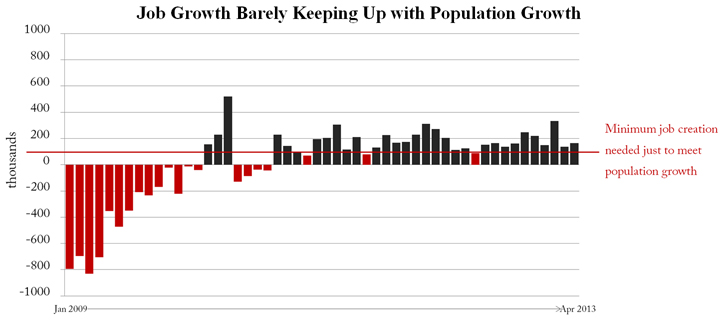We Need More Jobs
According to the Bureau of Labor Statistics, employment rose by 165,000 last month, and the jobless rate fell to 7.5 percent. These April gains favored retail and business services industries, while other major sectors of our economy continue to struggle. Job growth has not been consistent or broad-based enough for the Federal Reserve to pull back in its buying of $85 billion a month in long-term bonds.
A broader “real” measure of unemployment, the U-6 rate, increased last month to 13.9 percent.
- The real number of unemployed Americans is 21.9 million.
- These people:
- are unemployed (11.7 million);
- want work but have stopped searching for a job (2.3 million); and
- are working part time because they can’t find full-time work (7.9 million).
Despite positive reports in other areas of the economy, job growth remains sluggish. In 2012, the economy added an average of 262,000 jobs a month. In 2013, the economy has added an average of 196,000 jobs per month. The economy needs to add about 90,000 new jobs each month just to keep up with the growth in the working-age population.

Labor Force Participation Rate Lowest Since 1979
The labor force participation rate was 63.3 percent in April, down from 63.6 percent in January – it’s now at the lowest level since 1979. If the participation rate were the same as when President Obama took office, the unemployment rate would be 10.9 percent. Accounting for demographic trends, the unemployment rate would be 9.8 percent. The share of American adults with jobs in April was 58.6 percent – five percentage points below its pre-recession peak.
This is concerning because as people give up looking for work, they could drift so far away from the workforce that they never return when the economy picks up. Some will go on disability -- in March, 8.9 million people received federal disability insurance, up from 7.1 million when the recession began. Job skills also become rusty the longer a person is out of the workforce, requiring additional training or education to return to employment.
Another factor contributing to the lower labor force participation rate is that many older workers are choosing to retire early, likely with much less in savings than they had planned. Many younger workers are choosing to stay in school, often taking on huge student loan debt. According to the Institute for College Access and Success, the average college debt is at its highest level since they began collecting data in 2005, and the federal student loan default rate is at its highest level in 14 years.
Impediments to Hiring
Many businesses remain cautious and report worries about higher health care costs. In the April Beige Book, the Atlanta Fed reported “payrolls continued to grow at a tepid pace as firms remained reluctant in hiring due to uncertainty over … healthcare reform.”
Small business remains our economy’s primary source of job growth, and it is being hit hard by the President’s health care law, which requires employers with more than 50 full-time employees to provide health insurance. A growing number of employers are choosing instead to cut hours. Moody’s economist Mark Zandi confirmed that this sector is seeing a slowdown likely attributable to the health care law. The past month showed 278,000 more part-time workers.
Governments, which shed 11,000 jobs last month, are facing the same concerns with the impending implementation of health care reform. The city of Long Beach, California, recently made the decision to limit most of its 1,600 part-time workers to less than 27 hours a week. City officials explained that without trimming payroll hours, new health benefits would have cost them up to $2 million more next year.
Impediments to Growth
Another concern is the slow recovery of employee wages. Wages have been rising at about the same tepid two percent annually since the recession ended in 2009. In addition to affecting workers, this is also a problem for our economic recovery -- consumer spending accounts for roughly 70 percent of the economy. Continued economic uncertainty and concern with the effect of Obamacare have combined to incentivize businesses to show restraint in hiring and growth.
Next Article Previous Article
